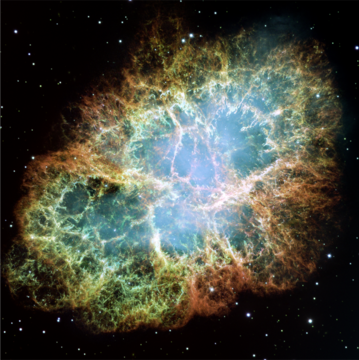A supernova is a powerful and luminous stellar explosion. This transient astronomical event occurs during the last evolutionary stages of a massive star (at least five times the mass of our sun) or when a white dwarf is triggered into runaway nuclear fusion.
In the first case, massive stars burn huge amounts of nuclear fuel at their cores, or centers. This produces tons of energy, so the center gets very hot. Heat generates pressure, and the pressure created by a star’s nuclear burning also keeps that star from collapsing. A star is in balance between two opposite forces. The star’s gravity tries to squeeze the star into the smallest, tightest ball possible. But the nuclear fuel burning in the star’s core creates strong outward pressure. This outward push resists the inward squeeze of gravity. When a massive star runs out of fuel, it cools off. This causes the pressure to drop. Gravity wins out, and the star suddenly collapses. The collapse happens so quickly that it creates enormous shock waves that cause the outer part of the star to explode! Then, the original object, called the progenitor, either collapses to a neutron star or black hole, or is completely destroyed. The peak optical luminosity of a supernova can be comparable to that of an entire galaxy before fading over several weeks or months.

In the second case, supernova can happen in systems where two stars orbit one another and at least one of those stars is an Earth-sized white dwarf. A white dwarf is what’s left after a star the size of our sun has run out of fuel. If one white dwarf collides with another or pulls too much matter from its nearby star, the white dwarf can explode!

The hot material given off by the supernova, the radioactive isotopes, and the free electrons moving in the strong magnetic field of the neutron star… all of these things produce X-rays and gamma rays. These high-energy photons are used by astrophysicists to study the phenomena of neutron stars and supernovae.
The supernova remnants or SNRs are diffuse, spreading systems that arise from a supernova explosion. They include ejected debris from the blast and other interstellar material sucked up by the shock wave from the exploding star. Astronomers are interested in supernova remnants because they play an important role in the evolution of galaxies, dispersing the heavy elements produced by supernova explosions and supplying the energy required to warm up the interstellar medium. Experts also believed that SNRs caused the acceleration of interstellar cosmic rays. The following image shows the image of a supernova remnant as it is seen in different wavelength regimes.

With the eROSITA X-ray telescope onboard SRG, astronomers at the Max Planck Institute for Extraterrestrial Physics have detected the largest in terms of apparent size supernova remnant ever observed in X-rays. The supernova remnant (SNR) of Hoinga ,as it is called, is massive and far from the galactic plane, which is quite rare. It occupies an area approximately 90 times larger than the full Moon, with a diameter of about 4.4 degrees. Astronomers expect about 1,200 SNRs to be in our Galaxy, however only about 300 have been found so far. Learn more here: http://ahead.astro.noa.gr/?p=1688 , source: spaceplace.nasa.gov, imagine.gsfc.nasa.gov
